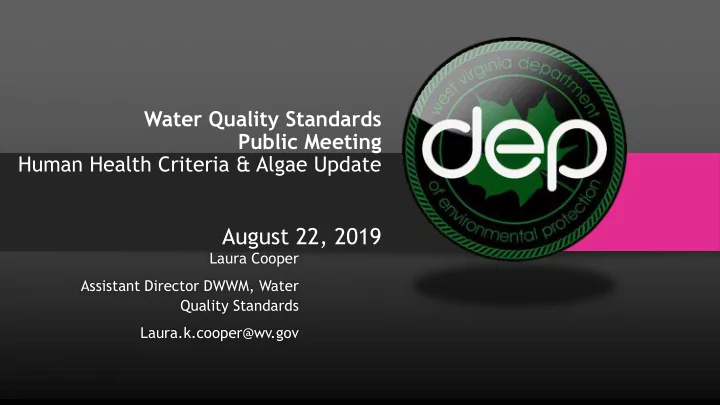

Water Quality Standards Public Meeting Human Health Criteria & Algae Update August 22, 2019 Laura Cooper Assistant Director DWWM, Water Quality Standards Laura.k.cooper@wv.gov
Water Quality Standards Public Meeting Agenda 2 • Schedule of upcoming Water Quality Standards review • Human Health Criteria Bioaccumulation Factors • Nutrients and Algae Update by Chris Smith • Discussion and Questions Agenda uploaded on 8/14/19 to https://dep.wv.gov/WWE/Programs/wqs/Pages/WQSpublicmeetings.aspx
Mandate from WV Legislature 3 to propose in 2020 Added Subsection 8.6. to 47CSR2: On or before April 1, 2020, the Secretary shall propose updates to the numeric human health criteria found in Appendix E., subsection 8.23 Organics and subsection 8.25 Phenolic Materials to be presented to the 2021 Legislative Session. The Secretary shall allow for submission of proposed human health criteria until October 1, 2019, and for public comment and agency review for an appropriate time thereafter.
Review of Triennial Review 4 Legislative Review 2019 May – Held public meeting to further discuss potential criteria revisions August – Holding this WQS public meeting By October 1 st – DEP will receive any submissions of proposed human health criteria November – Hold Public Meeting to hear presentations of any submittals proposed
proposal of Human Health Criteria 5 Timeline 2020 March – Hold WQS Public Meeting to propose human health criteria revisions June – Put out official public notice version of criteria revisions July – Hold public hearing and submit Agency-Approved rule for Legislative review Fall 2020 – Rule will be reviewed by Legislative Rule-Making Review Committee 2021 Legislative Session – Legislature will review proposed rule
Human Health Criteria 6 Bioaccumulation Factors, or “BAFs” “Bioaccumulation” ➢ Refers to the uptake and retention of a chemical by an aquatic organism from all surrounding media, such as food, water and sediment as opposed to “Bioconcentration” ➢ Refers to the uptake and retention of a chemical by an aquatic organism from water only ➢ EPA 2000 Methodology for Deriving Bioaccumulation can be Ambient Water Quality Criteria for the substantially greater than Protection of Human Health emphasizes bioaccumulation for chemicals that are that are highly using BAFs when possible persistent and/or hydrophobic
Human Health Criteria 7 EPA’s development of national BAFs ➢ Approach was to develop a long-term average bioaccumulation potential in aquatic organisms which are commonly consumed in the U.S. ➢ EPA estimated BAFs using its 2000 Methodology and its Technical Support Document, Volume 2: Development of National Bioaccumulation Factors ➢ EPA followed approach from Figure 3-1 of Tech Support Document, which provides different methods to derive the most appropriate BAF for each chemical
Human Health Criteria 8 Methods for Deriving most appropriate BAF BAF Method ➢ Uses measured BAFs derived from data obtained from field studies ➢ Field-measured BAFs were normalized by adjusting for the water-dissolved portions of the chemical and the lipid fraction of fish tissue for each species, as well as the fraction of the total concentration of chemical in water that is freely dissolved. ➢ Averaged multiple field BAFs using geomean of normalized BAFs by species and trophic level ➢ Averaged BAFs across species to compute trophic level-based BAFs Source: ➢ Adjusts the BAFs by national default values for lipid content, organic https://www.regulations.go carbon content, and the K ow v/contentStreamer?docume ntId=EPA-HQ-OW-2014- ➢ EPA used 50 th percentile for organic carbon content 0135- 0234&contentType=pdf
Human Health Criteria 9 Methods for Deriving most appropriate BAF BCF Method ➢ Uses BAFs estimated from laboratory-measured bioconcentration factors (BCFs) with or without adjustment by a food chain multiplier. ➢ Similar to field BAFs, laboratory-measured BCFs are normalized with the lipid fraction and the fraction of the total concentration of chemical in water that is freely dissolved, then multiplied by the food chain multiplier where applicable. ➢ Averaged using geomean across species and across trophic levels to compute baseline BAFs Source: ➢ Adjusts the BAFs by national default values for lipid content, organic https://www.regulations.go carbon content, and the K ow v/contentStreamer?docume ntId=EPA-HQ-OW-2014- ➢ EPA used 50 th percentile for organic carbon content 0135- 0234&contentType=pdf
Human Health Criteria 10 Methods for Deriving most appropriate BAF K ow Method This method predicts BAFs based on a chemical’s Octanol-Water Coefficient (or K ow ) with or without adjustment using a food chain multiplier Amount of chemical in octanol K ow = Amount of chemical in water Basically K ow measures the Source: tendency of a chemical to stay in https://www.regulations.go lipids vs go into water, or its v/contentStreamer?docume hydrophobicity ntId=EPA-HQ-OW-2014- 0135- 0234&contentType=pdf
First, Human Health Criteria 11 EPA Decision Tree / Framework then Figure 3-1 from Tech Support Document For example, acenaphthene : Nonionic organic chemical • Low hydrophobicity (K ow < 4) • • High metabolism For acenaphthene EPA was not able to locate peer-reviewed BAFs or lab- measured BCFs for all three trophic levels, so EPA used available BCF for TL3 to estimate and derive national BAF for acenaphthene of 510 L/kg
Specific Criteria Documents 12 Nat’l Recommended WQC HHC Table https://www.epa.gov/wqc/national-recommended- water-quality-criteria-human-health-criteria-table
Jennie Henthorn, Manufacturer's Association 13 Update from ongoing study of EPA’s Bioaccumulation Factors
Determination of Criteria Factors
Summary of Studies Reviewed
Study Age
Example Study in EPA Spreadsheet
Golden Ide Data from Study • Data in yellow indicates parameters reported in the Freitag study but not included in the EPA database.
EPA’s Order of Preference for Determination of Bioaccumulation Factors:
Basis for EPA Recommended Bioaccumulation Factors
Factors Used in BAFBCF TM to Calculate BAFs
Discussion 22 What questions do you have on human health criteria and bioaccumulation factors?
Chris Smith 23 Update on Algae and Nutrients
Recommend
More recommend